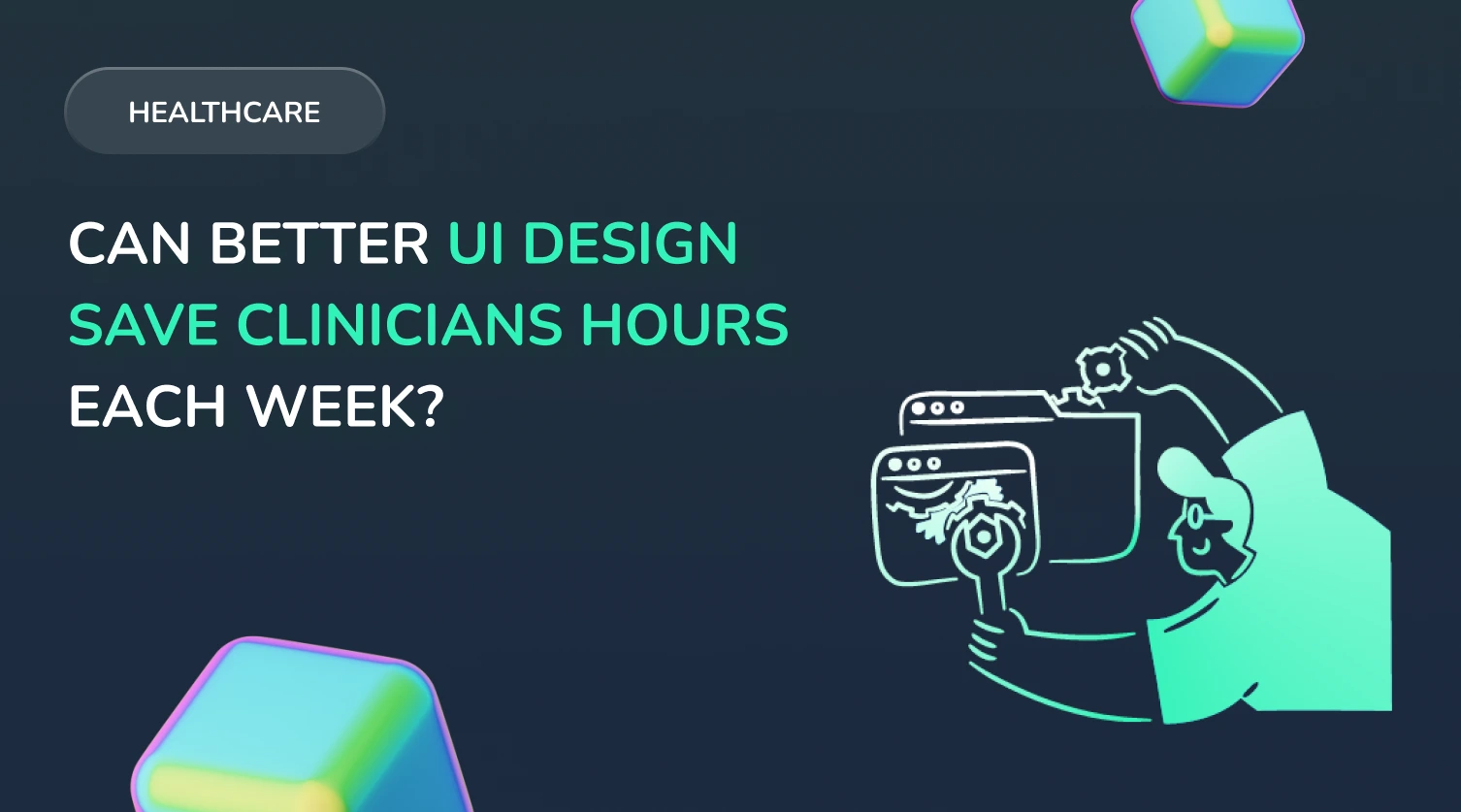
If you’ve ever implemented an EHR system or launched a digital product in the healthcare field, you’ve probably experienced this:
- The system exists, but it’s hard to use.
- Doctors are frustrated, admins are confused, and patients don’t know where to click.
- Instead of improving processes, you get constant requests to “fix this,” “make it simpler,” or “bring back the old version.”
This raises a fair question:
If we paid for development, why is the system slowing us down instead of helping the business grow?
One of the most overlooked reasons is UX design in healthcare. It’s not just about appearance or how “pretty” the interface is. It’s about how intuitive, efficient, and safe the system feels in real work. In medical products, healthcare UX has a direct impact on profitability, speed, safety, and satisfaction for both staff and patients.
Studies confirm that poor medical user experience (UX) design increases the likelihood of mistakes, delays information flow, and reduces user satisfaction. More than 50% of doctors report experiencing digital burnout due to poorly designed electronic health record (EHR) interfaces.
A well-crafted UX for healthcare does more than just simplify tasks; it enhances the overall user experience. It:
- Reduces errors in documentation
- Speeds up patient intake and service
- Improves patient loyalty
- Make your product stand out in the market
In this article, we’ll explain how medical user interface design can turn an EHR system from a source of stress into a trusted tool. You’ll see how a business can gain real benefits from great healthcare app design, without needing to dive into technical details. We’ll also show why delaying this work can cost you thousands and how to avoid common mistakes.
What Is UX Design for Healthcare?
Simply put, UX (user experience) refers to the ease and comfort with which users interact with a system. Many associate UX design with healthcare with something “modern” or “stylish,” but it’s not about buttons or colors. It’s about completing tasks efficiently and effectively.
For example, how can a doctor enter a diagnosis in 10 seconds? How does a patient find their test results easily? Or how can an admin schedule an appointment in a couple of clicks, without going through 5 screens or reading a manual?
In healthcare, this is critical. Mistakes caused by poor healthcare UI can cost not only time but also affect lives. Doctors are overloaded. They don’t have extra minutes or patience to deal with confusing navigation or unclear layouts. If your product forces them to learn how to use it, it’s already losing efficiency.
What’s the Difference Between UX and UI in Healthcare Products?
UI (user interface) refers to visual elements, buttons, fonts, and colors. UX is the logic behind it all, making it easy to achieve results.
A “Save” button that looks nice (UI) is useless if it’s hidden in the wrong place or labeled confusingly (UX). Even if your medical UI design follows brand guidelines, doctors may still forget to click “Confirm” before closing a visit.
So, what makes a good UX design for medical systems?
- Shorter onboarding and training for staff
- Fewer mistakes when entering or retrieving data
- Faster workflows and more transparency
- Higher satisfaction and patient return rate
UX design for healthcare systems is a tool that increases your product’s value. In today’s overloaded and competitive medical market, the easier and faster your tool is, the more trust, sales, and growth you’ll gain.
Whether you’re building a new solution or improving an existing one, healthcare user experience design is not optional; it’s essential. If your goal is to create a reliable, user-centered, and scalable product, your first step should be to invest in professional UI/UX design services for healthcare.
We help healthcare providers transform complex digital workflows into systems that actually work for doctors and patients. From medical interface design to long-term healthcare system design strategies, our team ensures that your product is not only functional but also truly helpful.
Why Poor UX in EHR Systems Is a Business Problem, Not Just a Design Flaw
As you may already be aware, poor user experience in healthcare systems impacts not only the comfort of doctors and patients but also the overall effectiveness of healthcare services. In reality, it triggers a chain of costly consequences that directly impact the business side of medicine. When a medical interface design is confusing, healthcare professionals spend more time on routine tasks, like entering data, issuing referrals, or searching for information. This means fewer patients are seen per day, resulting in the clinic consistently losing money.
Even worse, poor UX design in healthcare increases the risk of critical errors. If the interface isn’t straightforward, a diagnosis might not be saved, prescription details could get lost, or the “confirm” button might be missed. This leads not only to reputation damage but also to legal consequences. Mistakes in EHR systems can result in lawsuits, audits, and financial penalties.
Patients feel the impact, too. If receptionists mix up schedules, doctors are more focused on the screen than on the patient, and the patient portal is hard to navigate, that’s a poor experience. In healthcare user experience design, this often leads to negative reviews, reduced trust, and customer churn.
Healthcare systems with weak user experience (UX) become outdated more quickly. You’ll find yourself constantly redesigning the medical UI, retraining staff, and spending more money, but the system’s value doesn’t improve. That’s why UX design for healthcare is not just about aesthetics, it’s a long-term investment.
Bad UX is an invisible leak of money, time, and brand value. Treat healthcare UX design as a strategic investment, not just a designer’s task. With better UX, healthcare systems reduce costs, improve efficiency, and create products that truly support your business goals.
Key Principles of Great UX Design in Medical Systems
In a high-pressure medical environment where time is critical, effective UX design in healthcare works like a navigation tool. It clears out distractions, helps users focus, and reduces the risk of mistakes. Several key principles are especially important for healthcare app design and Electronic Health Record (EHR) systems. These principles ensure your product delivers real value.
1. Simplicity
This doesn’t mean your medical UI should be boring it means every screen, field, and button must have a clear purpose. Doctors don’t have time to “read” interfaces. In one of our projects, we redesigned an overly complex EHR system with too many fields, tiny fonts, and unclear navigation. By focusing on only what the doctor needed in each specific context, we reduced the time to complete a medical form by 35% and nearly eliminated errors. This is a key example of successful ux design in healthcare.
2. Predictability
The doctor must know precisely what will happen when they click a button. Will the diagnosis be saved? Will the patient get a notification? A stable and consistent medical user interface design reduces stress and streamlines workflows. If each screen behaves differently, it breaks trust in the system.
3. Context Awareness
The interface should adapt to the task at hand. For example, during an appointment, the system should display the patient’s card, symptoms, and history. At discharge, only essential details for the summary should appear. Contextual design supports faster and better decisions — a core of ux for healthcare.
4. Role-Based Access
Different users need different data. A doctor shouldn’t see what a receptionist sees. Patients don’t need technical info, but nurses may need vital signs and treatment plans. In one case, separating roles in the medical app UI design reduced system errors by nearly 50%, as each user accessed only relevant information. This demonstrates how UI/UX design in healthcare can enhance both safety and productivity.
Healthcare UX Design Is a Business Tool
Effective medical UX design reduces workload, increases accuracy, and enables your team to work smarter. Most importantly, it makes your healthcare app design truly enjoyable to use. Investing in healthcare user interface design today means building a more effective, reliable, and profitable system tomorrow.
Whether you’re creating a new medical UI, improving an EHR, or launching a healthcare platform, always prioritize UX design in healthcare as a foundation, not an afterthought. After all, a well-designed healthcare system is not just suitable for users, it’s great for business.
Why You Should Trust UX Professionals Instead of “Just Doing It Yourself”
Even if you have a good eye for design or your friend is a talented artist, this doesn’t guarantee success when it comes to UX design in healthcare. A working healthcare UX goes far beyond aesthetics it needs to function within the high-pressure, highly regulated medical environment, where staff are already overloaded. That’s why medical UX design must be built on real research, clear user scenarios, and proven behavior patterns, not guesswork.
A Real-Life Example
Let’s take a closer look. A doctor usually has just a few minutes with each patient. They don’t have time to study a complex medical user interface design; they need to act quickly and accurately. Meanwhile, the administrator focuses on fast scheduling, and the patient wants clarity and ease. These users interact with the system differently, so without proper healthcare UX design, you lose both efficiency and revenue.
UX and Architecture Go Hand in Hand
You can’t separate medical UX from system architecture. Even the best medical UI design is useless if it runs on a slow or poorly structured system. That’s why healthcare system design must be developed alongside UX design for healthcare. Without this connection, UX becomes just a “pretty picture” that can’t be implemented effectively.
Self-made decisions often lead to costly rework, wasted time, and missed opportunities. A professional approach to ui ux design in healthcare helps avoid these problems. It’s like building a house with a solid blueprint, rather than randomly assembling parts. You invest once, but get a scalable healthcare app design that performs well and keeps users satisfied for years.
How the Combination of UX and Technical Architecture Creates a Powerful Medical Product
If you want your product to stay relevant and grow with innovations like AI and telemedicine, your ux design for healthcare needs to be built with the future in mind. Here’s how to do it:
- Design a modular UX: By breaking the interface into focused sections, such as patient registration, medical history, and treatment plans. This improves clarity and simplifies updates.
- Build a scalable architecture: Secure your system so that it can easily expand by adding new modules without needing a full redesign.
- Adapt the medical interface design for different roles: For example, a doctor needs clinical data, while a nurse may focus on vital signs. Patients benefit from simplified, clear views.
- Plan for integrations: Secure your system to connect smoothly with external technologies like AI systems or telehealth platforms, supporting a unified healthcare user interface design.
- Update regularly: Utilize user feedback and new regulations to improve continually, eliminating the need for expensive redesigns.
With us, you’re not just getting a clean medical app UI design. You’re building the foundation for innovation, long-term success, and a real competitive advantage in the healthcare user experience design space.
By treating ux for healthcare as a strategic investment, not just a design task, you’re creating a product that works better, scales faster, and truly supports both your users and your business.
What You Get When You Trust Medical UX to Experts
When professionals take care of UX design in healthcare, the result is much more than just a “nice-looking” interface. You get a real working solution designed for clinical reality: it reduces the workload for doctors, speeds up processes, and improves patient satisfaction. Doctors find it easier to handle appointments because the medical user interface design adapts to their habits. Fewer clicks, less confusion, more time for patients instead of screens.
For patients, this is also a big win. Clear navigation, accurate medical records, fewer prescription mistakes, and smooth communication through the healthcare app design or portal all build trust and loyalty, which is essential in a competitive environment.
Such a system is also easier to implement. Because it’s intuitive, staff don’t need weeks of training and don’t resist change; they’re happy to switch to something that really helps them work better. For business owners, this means less downtime, reduced training costs, and fewer support issues.
Scalable UX Is a Foundation for Growth
A well-designed medical UX is not just about usability it sets the stage for growth. Today, you automate appointment scheduling; tomorrow, you add AI assistants, telemedicine features, or integrations with other platforms. A scalable ux design medical approach allows your product to grow without needing constant redesign.
A business built with proper healthcare ux design is worth more. A user-friendly, stable, and scalable solution isn’t just software; it becomes a competitive advantage and increases the investment appeal of your project.
Thoughtful UX Saves Resources and Boosts Competitiveness
UX design for healthcare isn’t just about making things look good. It’s about reducing human error, saving time, cutting costs, and gaining trust. When the healthcare UI design is intuitive for doctors, clear for patients, and logical for administrators, you get more than just a user interface; you get a powerful tool that drives real business results.
A properly designed healthcare user experience design leads to faster adoption, easier scaling, fewer redesigns, and quicker returns on investment. Companies that invest in strong ux healthcare from the beginning save resources and reach the market faster.
Most importantly, they create products that people trust.
Subscribe to our blog


